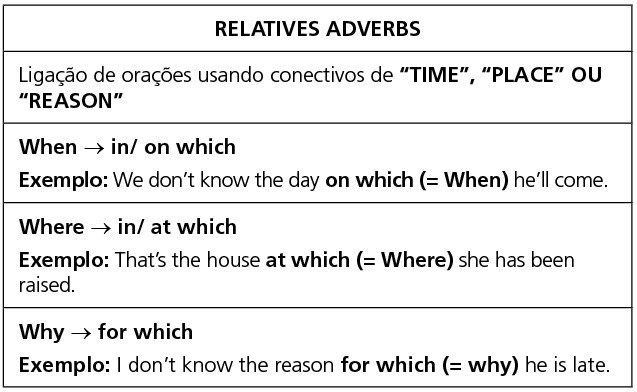PRONOMES RELATIVOS
Who; That – usados para pessoa, função na frase de sujeito.
Exemplo: The man who sells fish in the market is john.
Who; That; Whom usados para pessoas, função na frase de objeto.
Exemplo: The man who/whom you saw in the market is john.
Whose usado para pessoas e indica possessão.
Exemplo: The writer whose books are bestsellers is Brazilian.
Which; That usados para objetos ou animais, função na frase de sujeito.
Exemplo: The TV set which (that) is at the right side of the window is mine.
The refrigerator which/that is my kitchen is from the USA.
Which – That usados para objetos ou animais, função na frase de objeto.
Exemplo: The carpet which/that I bought in São Paulo is in the living room.
Of Which – Whose usados para animais ou objetos e indica possessão.
Exemplo: The house whose windows are big is John’s.
ORAÇÕES ADJETIVAS (ADJECTIVES CLAUSES)
Orações Adjetivas informam a respeito do substantivo ou pronome, sujeitos ou não. Tais orações geralmente aparecem logo depois das palavras que elas modificam. Temos dois tipos de Orações Adjetivas: “restrictive” (defining) ou “nonrestrictive” (nondefining).
As orações “restrictive” ou “defining” identificam o(s) substantivo(s); elas descrevem; elas dão informações que são necessárias que são importantes para o sentido da oração.
Exemplos:
Many of the men who (that) work at Petrobras have medical care.
Most of the cars which (that) the police bought came from England.
Observação: Nesses casos os pronomes “who” e “which” podem ser substituídos por “that”.
As orações “nonrestrictives” ou “nondefining” não definem ou identificam o(s) substantivo(s); elas apenas dão informações extras que são desnecessárias para a identificação do(s) substantivo(s).
Exemplos: President Ronald Reagan, who was shot, governed the USA during the cold war.
The sun, which appears in many ancient drawings, was an important religious symbol.
Observação: Nesses casos os pronomes “who” e “which” não podem ser substituídos por “that”.
E o pronome “whose” é usado em orações “restrictive” assim como em orações “nonrestective”, o pronome “whose” não pode ser omitido.
PRONOMES RELATIVOS NA FUNÇÃO DE SUJEITO
Os pronomes relativos quando aparecem entre o sujeito e o verbo não podem ser omitidos da frase, pois fazem papel de sujeito.
Exemplos:
Pessoas:
The man who (that) died was John, my neighbor.
I spoke to John, who was very bright.
(Apenas o pronome “who” pode ser usado aqui.)
Animais ou coisas:
The building which (that) is the most famous is “Avenida Rio Branco 1”.
Architects draw the new building, which is near Tijuca.
PRONOMES RELATIVOS NA FUNÇÃO DE OBJETO
Os pronomes relativos quando substituem o objeto do verbo ou objeto de uma preposição podem ser omitidos da oração, menos quando a oração for “nonretrictive” ou “non defining”.
Exemplos:
Pessoas:
The man who/whom John sold the dvd is peter.
(O pronome relativo pode ser omitido nesse caso.)
Animais ou coisas:
John wrote about the American History, which he had studied for years.
(Nesse caso, em oração “nonrestrictive” ou “nondefining” o pronome não pode ser omitido.)
PRONOMES OBJETOS DA PREPOSIÇÃO
Quando a preposição aparecer antes do pronome relativo, apenas o “whom” ou o “which” podem ser usados, mas caso a preposição apareça no final de uma oração “restrictive” o pronome “that” pode ser usado ou o pronome relativo pode ser omitido.
Exemplos:
Pessoas:
The historians were British. Many ideas to the book came from them.
The historians from whom many ideas came were British.
The historians who (that) many of our ideas came from were British.
Animais ou coisas:
The books were written by Brazilians. Most of the information came from these books.
The books from which most of the information came were written by Brazilians.
The books (that, which) most of the information came from were written by Brazilians.
Uso do “where”
Exemplos:
This is a farm where (on which) a famous writer was brought up.
This is Easter Island, where (on which) John Kennedy lived for years.
PRONOMES RELATIVOS COM EXPRESSÕES DE “QUANTITY”
Exemplos:
They selected five candidates. One candidate would get the job.
They selected five candidates, one of whom would get the job.
These statues are world famous. Many of them weigh over twenty tons.
These statues, many of which weigh over twenty tons, are world famous.






